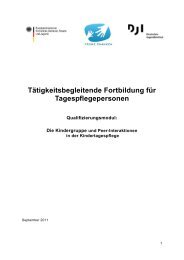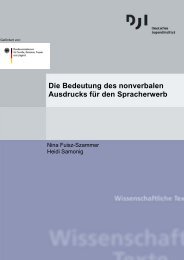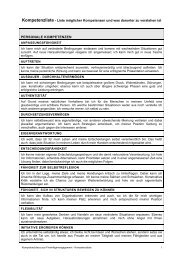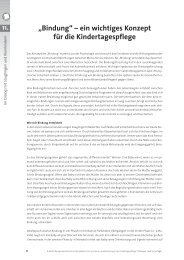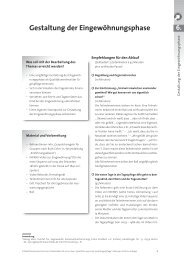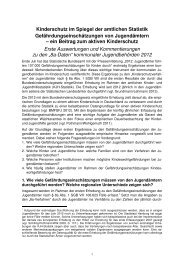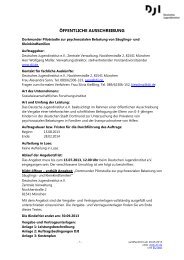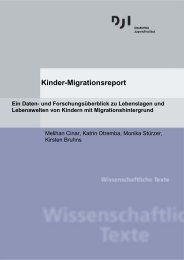Assessing the effects of informal learning on occupational compe ...
Assessing the effects of informal learning on occupational compe ...
Assessing the effects of informal learning on occupational compe ...
Create successful ePaper yourself
Turn your PDF publications into a flip-book with our unique Google optimized e-Paper software.
which is also characteristic <str<strong>on</strong>g>of</str<strong>on</strong>g> <str<strong>on</strong>g>the</str<strong>on</strong>g> ACs used for disadvantaged young people.<br />
Using as many methods as possible (questi<strong>on</strong>ing and assessment by<br />
<strong>on</strong>eself and by observers, participant and n<strong>on</strong>-participant systematic observati<strong>on</strong>,<br />
etc.), <strong>compe</strong>nsates for <str<strong>on</strong>g>the</str<strong>on</strong>g> errors <str<strong>on</strong>g>of</str<strong>on</strong>g> individual methods. For <str<strong>on</strong>g>the</str<strong>on</strong>g><br />
same reas<strong>on</strong>s, <strong>on</strong>e test pers<strong>on</strong> is observed by various observers (assessors)<br />
and his or her performance and behaviour are evaluated. This is intended to<br />
neutralize subjective assessment errors (Ebbinghaus et al. 2003, p. 99).<br />
The procedure used to establish <strong>compe</strong>tence in <str<strong>on</strong>g>the</str<strong>on</strong>g> AC (by trained observers,<br />
assessors, etc.) also presupposes that <strong>on</strong>e can define and objectively<br />
measure <strong>compe</strong>tences (even social <strong>on</strong>es) as if <str<strong>on</strong>g>the</str<strong>on</strong>g>y were quantities in <str<strong>on</strong>g>the</str<strong>on</strong>g><br />
natural sciences. This applies in particular to target-oriented specialist and<br />
methodological <strong>compe</strong>tences emphasizing qualificati<strong>on</strong>s. However, precisely<br />
<str<strong>on</strong>g>the</str<strong>on</strong>g> <str<strong>on</strong>g>informal</str<strong>on</strong>g> social <strong>compe</strong>tences we are looking at here are <str<strong>on</strong>g>of</str<strong>on</strong>g>ten bey<strong>on</strong>d <str<strong>on</strong>g>the</str<strong>on</strong>g><br />
scope <str<strong>on</strong>g>of</str<strong>on</strong>g> this type <str<strong>on</strong>g>of</str<strong>on</strong>g> objective measurement by outside observati<strong>on</strong> and<br />
assessment. More recent efforts have <str<strong>on</strong>g>the</str<strong>on</strong>g>refore been moving towards an<br />
‘extended view <str<strong>on</strong>g>of</str<strong>on</strong>g> <strong>compe</strong>tence measurement that includes qualitative<br />
aspects’ (Arbeitsgemeinschaft QUEM 2004, p. 3). This approach also takes<br />
greater account <str<strong>on</strong>g>of</str<strong>on</strong>g> <str<strong>on</strong>g>informal</str<strong>on</strong>g> <str<strong>on</strong>g>learning</str<strong>on</strong>g> and <str<strong>on</strong>g>informal</str<strong>on</strong>g>ly acquired <strong>compe</strong>tences.<br />
By c<strong>on</strong>trast, <str<strong>on</strong>g>the</str<strong>on</strong>g> traditi<strong>on</strong>al procedures for measuring and establishing <strong>compe</strong>tence<br />
are based <strong>on</strong> a quasi-mechanical, quantitatively measurable c<strong>on</strong>cept<br />
<str<strong>on</strong>g>of</str<strong>on</strong>g> <strong>compe</strong>tence. The same applies to most procedures for measuring and<br />
establishing <strong>compe</strong>tence in disadvantaged young people.<br />
2.3 Measurement and establishment <str<strong>on</strong>g>of</str<strong>on</strong>g> <strong>compe</strong>tence in disadvantaged<br />
young people<br />
2.3.1 Methods and procedures<br />
On <str<strong>on</strong>g>the</str<strong>on</strong>g> basis <str<strong>on</strong>g>of</str<strong>on</strong>g> <str<strong>on</strong>g>the</str<strong>on</strong>g> special characteristics <str<strong>on</strong>g>of</str<strong>on</strong>g> <str<strong>on</strong>g>the</str<strong>on</strong>g> target group (including<br />
school deficits) and <str<strong>on</strong>g>the</str<strong>on</strong>g> aims (more suitable individual support and job placement),<br />
<str<strong>on</strong>g>the</str<strong>on</strong>g> methodological implementati<strong>on</strong> <str<strong>on</strong>g>of</str<strong>on</strong>g> <str<strong>on</strong>g>the</str<strong>on</strong>g> procedure for establishing<br />
<strong>compe</strong>tence should be oriented towards <str<strong>on</strong>g>the</str<strong>on</strong>g> methodological breadth <str<strong>on</strong>g>of</str<strong>on</strong>g><br />
<str<strong>on</strong>g>the</str<strong>on</strong>g> available survey instruments and should make use <str<strong>on</strong>g>of</str<strong>on</strong>g> various procedures<br />
and instruments. Acti<strong>on</strong>-oriented procedures such as <str<strong>on</strong>g>the</str<strong>on</strong>g> Assessment Centre<br />
have clear advantages in particular for <str<strong>on</strong>g>the</str<strong>on</strong>g> evaluati<strong>on</strong> c<strong>on</strong>text and <str<strong>on</strong>g>the</str<strong>on</strong>g> target<br />
group, particularly if <str<strong>on</strong>g>the</str<strong>on</strong>g> individual and group tasks to be solved – depending<br />
<strong>on</strong> <str<strong>on</strong>g>the</str<strong>on</strong>g> objective – are oriented towards practical activities and <str<strong>on</strong>g>the</str<strong>on</strong>g> c<strong>on</strong>texts<br />
<str<strong>on</strong>g>of</str<strong>on</strong>g> <str<strong>on</strong>g>the</str<strong>on</strong>g> young people’s life-world. ‘Both open and prestructured acti<strong>on</strong>related<br />
procedures are regarded as particularly important in <str<strong>on</strong>g>the</str<strong>on</strong>g> young people<br />
included here, since <str<strong>on</strong>g>the</str<strong>on</strong>g>se procedures can be used both in <str<strong>on</strong>g>the</str<strong>on</strong>g> specialist<br />
field and in open problem situati<strong>on</strong>s and decisi<strong>on</strong> situati<strong>on</strong>s. They provide<br />
an opportunity for self-organized acti<strong>on</strong> and <str<strong>on</strong>g>the</str<strong>on</strong>g>reby support <str<strong>on</strong>g>the</str<strong>on</strong>g> participants’<br />
motivati<strong>on</strong>’ (Hiba 2003, p. 6).<br />
‘Methods <str<strong>on</strong>g>of</str<strong>on</strong>g> this type have also been very popular for several years in working<br />
with people who have serious problems in gaining a foothold in <str<strong>on</strong>g>the</str<strong>on</strong>g><br />
job market’ (Druckrey 2001, p. 15). There are good reas<strong>on</strong>s for this boom<br />
in ACs (and similar procedures for establishing <strong>compe</strong>tence): ‘ACs … make<br />
it possible for young people to recognize <str<strong>on</strong>g>the</str<strong>on</strong>g>ir individual occupati<strong>on</strong>al abilities,<br />
skills, strengths, and preferences and to find out about <str<strong>on</strong>g>the</str<strong>on</strong>g>ir skills and<br />
<strong>compe</strong>tences both in dealing with everyday life and in <str<strong>on</strong>g>the</str<strong>on</strong>g> field <str<strong>on</strong>g>of</str<strong>on</strong>g> social<br />
9 <str<strong>on</strong>g>Assessing</str<strong>on</strong>g> <str<strong>on</strong>g>the</str<strong>on</strong>g> <str<strong>on</strong>g>effects</str<strong>on</strong>g> <str<strong>on</strong>g>of</str<strong>on</strong>g> <str<strong>on</strong>g>informal</str<strong>on</strong>g> <str<strong>on</strong>g>learning</str<strong>on</strong>g> <strong>on</strong> occupati<strong>on</strong>al <strong>compe</strong>tences <str<strong>on</strong>g>of</str<strong>on</strong>g> disadvantaged young pers<strong>on</strong>s



